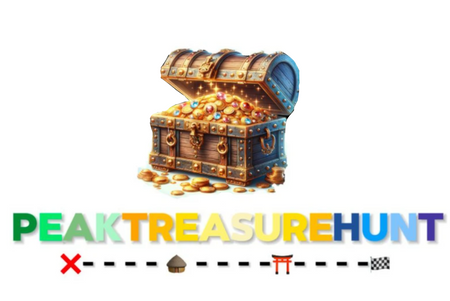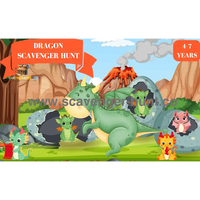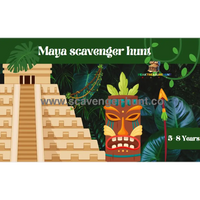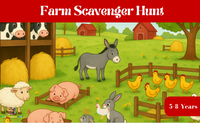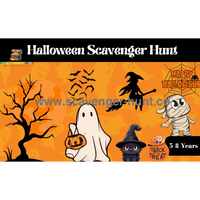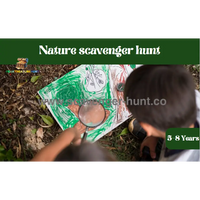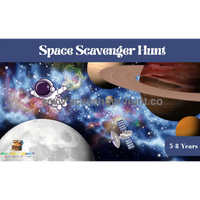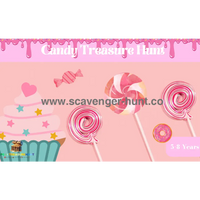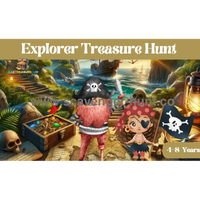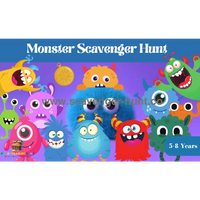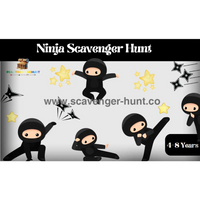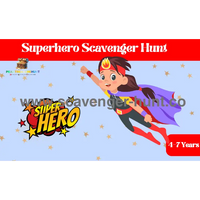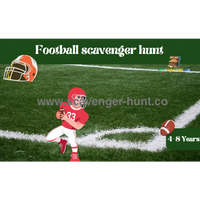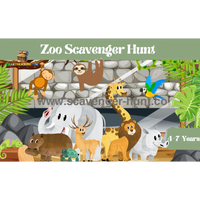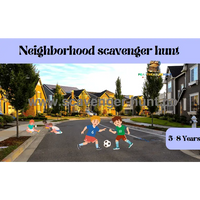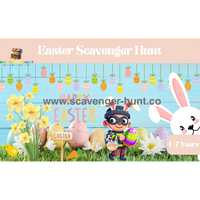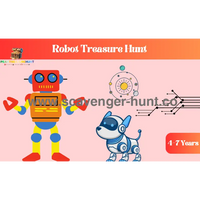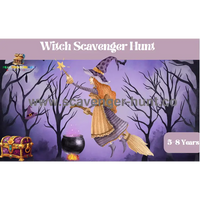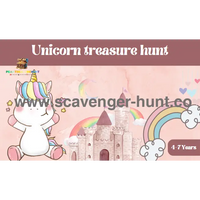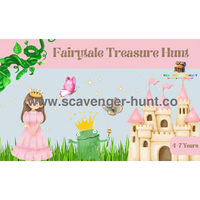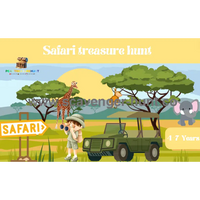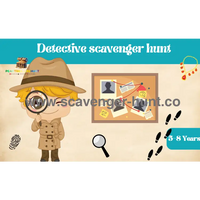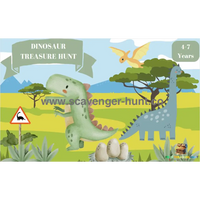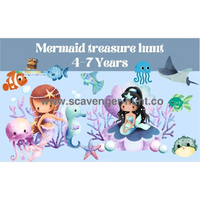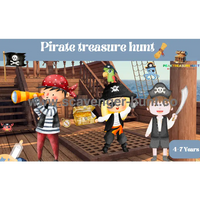🎉Educational Treasure Hunts: The Ultimate Guide for Teachers
Introduction
Transform ordinary lessons into extraordinary adventures with classroom treasure hunts! According to educational research, interactive learning activities like treasure hunts can increase student engagement by up to 87%. This comprehensive guide will help educators create exciting and educational hunt experiences that align with curriculum goals while maintaining classroom management. Whether you're planning a simple in-class activity or an elaborate school-wide adventure, these strategies will ensure your treasure hunt enriches learning while creating memorable experiences for students of all ages.
1: Designing Educational Treasure Hunts
Age-Appropriate Learning Objectives
- Grades K-2: Basic counting, letter recognition, shapes
- Grades 3-5: multiplication, vocabulary, science facts
- Grades 6-7: complex problem-solving, historical dates
Research shows that incorporating curriculum elements into treasure hunts improves information retention by 45%.
Essential Materials
- Subject-specific clue cards
- Educational prizes
- Answer sheets
- Safety guidelines
- Learning objective checklist
Treasure hunts are not just for parties and celebrations; they can also be powerful educational tools! Designing an educational treasure hunt is a fantastic way to engage students, reinforce learning objectives, and make education fun. By blending adventure with education, you can create an interactive experience that students will remember long after the last clue has been solved.
In this chapter, we’ll explore how to design an educational treasure hunt that sparks curiosity, promotes teamwork, and helps learners acquire new knowledge in an exciting way. Let’s get started!
Step 1: Define Your Learning Objectives 🎯📚
Before diving into the design, it’s essential to clearly define the educational goals you want to achieve. What specific skills or knowledge do you want the students to gain through the treasure hunt? Here are a few examples of learning objectives you might consider:
-
Subject-specific knowledge: If you're focusing on science, math, or history, make sure your clues and challenges are aligned with the curriculum. For example, you could incorporate math problems into clues that lead students to different locations.
-
Critical thinking and problem-solving: Create puzzles that require students to think critically and analyze information. This could be anything from riddles to logic puzzles that need to be solved to find the next clue.
-
Collaboration and teamwork: Design activities that encourage students to work together to complete challenges or find clues. This helps build important social skills while they learn.
-
Physical education: If you want to get kids moving, consider incorporating physical challenges that require them to run, jump, or even create a small obstacle course related to the subject matter.
Pro Tip: Write down your learning objectives before you start designing the treasure hunt. This will help you stay focused and ensure all activities align with your educational goals.
Step 2: Choose a Theme 🎉🌟
Selecting a theme can make your educational treasure hunt even more engaging. A strong theme will capture students’ imaginations and motivate them to participate. Here are a few ideas:
-
Historical Adventure: Take students on a journey through time by focusing on significant events or figures in history. Each clue could reveal a piece of history, like finding out about ancient civilizations or famous explorers.
-
Science Expedition: Focus on a specific branch of science, like biology, physics, or environmental science. Students could follow clues related to different scientific concepts or famous experiments.
-
Literary Quest: Create a treasure hunt based on a specific book, author, or literary genre. Each clue could require students to answer questions or solve problems based on their readings.
-
Math Mystery: Incorporate math concepts into the clues and challenges. Each clue could require solving a math problem to unlock the next location, or students might need to measure distances as part of their hunt.
Pro Tip: Choose a theme that resonates with your students’ interests. If they’re excited about the subject matter, they’ll be more engaged in the hunt!
Step 3: Create Clues and Challenges 📜🔍
Once you have your objectives and theme, it’s time to develop the actual clues and challenges that will guide students through the treasure hunt. Here’s how to craft engaging and educational activities:
-
Incorporate Different Learning Styles: Include a variety of clue types that appeal to different learning styles. Use visuals (like maps or diagrams), auditory clues (like riddles or recorded messages), and kinesthetic challenges (like physical tasks) to reach all students.
-
Design Puzzles and Riddles: Create challenges that require critical thinking. For example, you might provide a riddle that leads to a specific location or a puzzle that reveals a clue once solved. Keep it relevant to the subject matter!
-
Include Research Components: To make the hunt more interactive, you could incorporate research tasks. For instance, students may need to find information online or in books to answer a question and receive the next clue.
-
Make It Hands-On: For science-related hunts, consider using experiments or hands-on tasks as part of the challenges. For instance, they might need to build a simple structure with limited materials to solve a problem.
Pro Tip: Test your clues and challenges with a small group before the actual hunt to ensure they’re engaging and educational. This way, you can make adjustments if needed!
Step 4: Plan the Route 🗺️🚶♂️
With your clues and challenges in hand, it’s time to plan the treasure hunt route. This will ensure a logical flow and maintain excitement throughout the experience. Here are some tips for mapping out your route:
-
Logical Flow: Arrange the clues in a way that makes sense. Each clue should naturally lead to the next location, and you may want to consider any potential roadblocks or distractions along the way.
-
Diverse Locations: Use a variety of locations for the clues to keep students engaged. This could include different classrooms, the library, outdoor spaces, or even the cafeteria, depending on your setting.
-
Accessibility: Ensure that all students can access the clues and locations, especially if you have participants with different physical abilities. Make adjustments to the route if necessary.
-
Time Management: Consider how much time you want the treasure hunt to take. Make sure the distance between clues is manageable and allows students enough time to complete each task.
Pro Tip: Create a map of the route to help guide students, but consider making it a challenge in itself. Maybe they need to decode a legend or interpret symbols to navigate!
Step 5: Prepare Materials and Logistics 📦📝
Once you have the route and clues set, it’s time to prepare the materials needed for the hunt. This can include everything from physical clues to any supplies for challenges. Here’s a checklist to keep you organized:
-
Clue Cards: Print or write out each clue clearly. Consider using waterproof materials if the hunt will take place outdoors.
-
Supplies for Challenges: Gather any materials needed for hands-on tasks. For example, if students are building structures, make sure they have the necessary supplies (like straws, tape, and paper).
-
Prizes and Rewards: Decide what kind of rewards you’ll give participants at the end of the hunt. This could be anything from certificates of completion to small themed prizes.
-
Additional Support: If possible, recruit a few helpers to assist during the hunt. They can help monitor teams, provide hints, or keep track of time.
Pro Tip: Consider using technology for added excitement! Apps or QR codes can be used to provide digital clues or collect answers, adding a modern twist to your educational treasure hunt.
Step 6: Launch the Treasure Hunt 🚀🎊
Now that everything is ready, it’s time for the big day! Here’s how to launch the treasure hunt smoothly:
-
Gather Participants: Bring everyone together and explain the treasure hunt. Review the rules, objectives, and expectations so that everyone understands the process.
-
Team Assignments: If you’re working with teams, make sure everyone knows who they’re teamed up with. Encourage them to come up with a fun team name to foster camaraderie.
-
Hand Out the First Clue: Once everyone is ready and excited, hand out the first clue and let the adventure begin!
Pro Tip: Keep the atmosphere light and fun! Use music, themed decorations, or costumes to enhance the excitement. Your enthusiasm will set the tone for the entire hunt!
Step 7: Monitor and Support Teams 🌟👀
As the treasure hunt progresses, stay engaged and monitor the teams. Here are some ways to provide support:
-
Check in with Teams: Move around to different teams, offering encouragement and checking on their progress. This can help keep energy levels high and allows you to see how they’re doing.
-
Provide Hints When Needed: If a team gets stuck on a clue for too long, don’t hesitate to step in and offer a hint. This keeps the flow of the hunt moving and prevents frustration.
-
Foster Teamwork: If you notice some participants not contributing or struggling, encourage everyone to share ideas and work together. Team dynamics are key to a successful hunt!
Pro Tip: Keep a camera handy to capture moments throughout the hunt! These photos will be great for memories and can be shared later as a recap of the event.
Step 8: Conclude with a Reflection 🎤📣
After the treasure hunt has come to an end, it’s important to reflect on the experience. This helps solidify what students learned and gives them a chance to share their thoughts.
-
Gather Everyone Together: Bring all the teams back together for a debriefing session. This is a great time to celebrate their accomplishments and share stories from the hunt.
-
Discuss What They Learned: Encourage participants to share what they found challenging, what they enjoyed, and what new knowledge they gained. This reinforces the educational aspect of the event.
-
Present Awards: If you have prizes or certificates, this is the perfect moment to distribute them. A little recognition goes a long way in making students feel proud of their achievements!
Pro Tip: Consider giving out “superlative” awards (like “Best Team Spirit” or “Most Creative Problem-Solver”) in addition to regular prizes. This adds a fun twist to the celebration!
Step 9: Gather Feedback for Improvement 💬✍️
Once the treasure hunt is over, gather feedback to improve future events. Here’s how to collect useful insights:
-
Surveys or Discussions: After the event, ask participants to share their thoughts on what they liked and what could be improved. This could be done through informal discussions or a simple survey.
-
Reflect on Your Experience: Take some time to jot down your own observations.
2: Creating Educational Treasure Hunt Clues
Subject-Based Clue Examples
- Math: "Solve 3 x 4 to find how many steps to take forward"
- Language Arts: "Find a word that rhymes with 'light' to discover your next site"
- Science: "Look near the object that helps plants grow with H2O"
A 2023 study indicated that multi-subject hunts improve cross-curricular understanding by 56%.
Creating clues for an educational treasure hunt is one of the most exciting parts of designing the experience! The right clues not only guide participants through the hunt but also challenge their thinking, deepen their understanding, and keep them engaged. In this chapter, we’ll explore how to craft effective and educational clues that will make your treasure hunt a memorable adventure. Let’s get started!
Step 1: Align Clues with Learning Objectives 🎯📘
Before you start creating clues, it’s important to align them with your educational goals. Consider what knowledge or skills you want participants to gain from the experience. Here’s how to ensure your clues support these objectives:
-
Identify Key Concepts: List the main ideas or topics you want to cover. For example, if your treasure hunt focuses on a history lesson about ancient Egypt, your clues might reference pyramids, pharaohs, or hieroglyphics.
-
Incorporate Learning Activities: Think about how clues can incorporate activities that reinforce learning. This could include solving a math problem, answering a question about a book, or performing a science experiment as part of the clue.
Pro Tip: Keep your learning objectives visible as you create your clues to ensure everything stays on track!
Step 2: Choose the Right Clue Format 📝🔤
Different formats for clues can keep the treasure hunt exciting and cater to various learning styles. Here are some formats to consider:
-
Riddles: Create fun riddles that participants must solve to find the next clue. For example:
“I have keys but open no locks. I have space but no room. You can enter, but you can’t go outside. What am I?”
(Answer: A keyboard!)
-
Puzzles: Incorporate jigsaw puzzles or crossword puzzles that need to be completed to reveal the next location or clue.
-
Multiple Choice Questions: Pose educational questions with multiple-choice answers. For instance:
“Which planet is known as the Red Planet? A) Earth B) Mars C) Jupiter”
(Correct answer: B) Mars)
-
Visual Clues: Use images, maps, or diagrams as clues. For example, provide a picture of a famous landmark related to the subject matter, prompting participants to locate it.
-
Scavenger Hunt Items: Include items they need to find as part of the clues. For instance, participants might need to locate a specific book or object in the classroom or library.
Pro Tip: Mixing different formats will keep the participants engaged and cater to various learning preferences!
Step 3: Craft Engaging and Clear Clues 🕵️♂️✨
Clues should be engaging, clear, and challenging enough to spark curiosity. Here are some tips on crafting effective clues:
-
Use Clear Language: Avoid overly complex vocabulary that might confuse participants. Make sure your clues are understandable for the age group you are targeting.
-
Incorporate Themes and Stories: Add a narrative element to your clues to make them more engaging. For instance, you could create a storyline where participants are detectives solving a mystery or explorers uncovering ancient treasures.
-
Add Fun Elements: Incorporate humor or creative twists. For example, you might write a clue in the style of a pirate’s note or a detective’s case file. 🌊🏴☠️
-
Challenge, Don’t Frustrate: Strive for a balance between challenge and clarity. Clues should be intriguing enough to spark interest but not so difficult that participants become frustrated. If you find that a clue is too hard, consider simplifying it or providing hints.
Pro Tip: Test your clues with a small group before the actual event to gauge their clarity and difficulty level.
Step 4: Incorporate Collaborative Elements 🤝💡
Encouraging teamwork can enhance the learning experience and make the hunt more enjoyable. Here are some ideas for creating collaborative clues:
-
Team Challenges: Design clues that require teams to work together. For instance, they might need to solve a complex puzzle where each member contributes a piece of information.
-
Discussion Prompts: Include clues that require participants to discuss and brainstorm ideas. For example:
“Discuss among your team what you think the three most important events in American history are. Once you agree, head to the library and find a book about one of them!”
-
Role Assignments: Assign specific roles to team members, such as a navigator, a scribe, or a clue solver. This encourages everyone to participate and use their strengths.
Pro Tip: Emphasize the importance of communication and collaboration in your instructions to promote teamwork!
Step 5: Test and Refine Your Clues 🔍⚙️
Once you’ve created your clues, it’s crucial to test them to ensure they work as intended. Here’s how to refine your clues:
-
Run a Trial Hunt: Organize a mini treasure hunt with a small group of friends or colleagues to see how the clues flow. Pay attention to any points of confusion or frustration.
-
Gather Feedback: After the trial run, ask participants for feedback on the clues. Which ones did they enjoy? Were any too difficult or unclear?
-
Make Adjustments: Based on the feedback, adjust your clues as necessary. Sometimes small tweaks can make a big difference in clarity and engagement!
Pro Tip: Keep a notebook handy during your trial run to jot down observations and ideas for improvement!
Step 6: Create a Reward System 🏆🎉
No treasure hunt is complete without some form of reward! Consider how to acknowledge the participants' efforts at the end of the hunt:
-
Completion Certificates: Give out certificates for completing the treasure hunt. You can create fun titles like “Master Treasure Hunter” or “Clue-Solving Champion.”
-
Themed Prizes: Consider offering small themed prizes related to the educational topic. For example, if the hunt was about space, you might give out star stickers or mini-planet models.
-
Celebration Ceremony: Host a small celebration after the hunt where everyone shares what they learned and experiences they had. This can foster a sense of community and accomplishment.
Pro Tip: Celebrate everyone’s efforts! Even if a team didn’t win, they should feel appreciated for participating and learning.
Creating educational treasure hunt clues can be an incredibly rewarding and fun process. By aligning your clues with learning objectives, using various formats, and encouraging collaboration, you can design a treasure hunt that is not only educational but also a fantastic adventure. Get ready to watch students engage, learn, and have a blast as they follow your clues to the treasure! 🗺️🗝️✨
3: Managing Classroom Treasure Hunts
Group Organization Strategies
- Pairs for younger students
- Teams of 3-4 for middle grades
- Mixed-ability grouping
- Rotating team leaders
Educational psychologists recommend maintaining groups of 4 or fewer for optimal participation levels.
Managing a classroom treasure hunt can be one of the most exhilarating and rewarding experiences for both teachers and students! 🎈 It’s a fantastic way to combine learning with fun, encourage teamwork, and create lasting memories. In this chapter, we’ll cover everything you need to know to plan, execute, and wrap up a successful treasure hunt in your classroom. Let’s dive in!
Step 1: Planning the Treasure Hunt 📝🎯
The first step in managing a successful treasure hunt is thorough planning. Here’s how to get started:
-
Set Clear Objectives: Define what you want students to learn or accomplish during the treasure hunt. This could range from reinforcing a specific subject area, such as math or history, to promoting teamwork and problem-solving skills.
-
Choose a Theme: Selecting a fun and engaging theme can set the tone for your treasure hunt. It could be based on a subject (like “Science Adventure”), a favorite book, or even seasonal themes (like a “Fall Harvest Hunt”). 🎃📚
-
Determine Locations: Decide where the treasure hunt will take place. Will it be confined to the classroom, extend to the playground, or include multiple areas around the school? Ensure that all locations are safe and accessible.
Pro Tip: Make a map of the locations you’ll use. This can help you visualize the flow of the hunt and ensure a logical progression from clue to clue.
Step 2: Creating Clues and Challenges 🕵️♂️🧩
Once your plan is in place, it’s time to craft engaging clues and challenges that align with your learning objectives. Here’s how:
-
Align Clues with Learning Goals: Each clue should incorporate educational content. For example, if you’re teaching math, a clue could require solving a math problem to unlock the next location. If it’s a history theme, the clue might include a historical fact that students need to interpret.
-
Mix Formats: Incorporate various types of clues, such as riddles, puzzles, and visual clues. This keeps students engaged and caters to different learning styles. For example, a riddle could lead to a book, and a puzzle could reveal the next clue's location.
-
Ensure Clarity: Make sure your clues are clear and easy to understand. Avoid overly complex language that might confuse participants.
Pro Tip: Test your clues with a small group before the actual event. This can help identify any confusing parts and ensure that the clues are just challenging enough to be engaging.
Step 3: Organizing Teams 👥🤝
Organizing students into teams can enhance collaboration and make the treasure hunt more enjoyable. Here’s how to set up teams effectively:
-
Team Sizes: Decide on the size of each team. Smaller teams (3-5 students) often promote better communication and participation.
-
Diverse Skill Sets: Aim for diversity in your teams by mixing different skill sets and abilities. This way, each team has a range of strengths to draw upon, fostering collaboration.
-
Fun Team Names: Encourage teams to come up with creative names that reflect the theme of the treasure hunt. This adds an extra layer of excitement and camaraderie! 🎉
Pro Tip: Consider assigning roles within each team, such as a leader, a note-taker, or a clue-reader. This helps everyone feel involved and encourages teamwork.
Step 4: Setting Up the Hunt 🏁🔑
As the day of the treasure hunt approaches, it’s time to set everything up for success. Here’s a checklist to help you prepare:
-
Prepare Clue Stations: Set up each location with the necessary clues or materials. Make sure each clue is securely placed and ready for the teams to find.
-
Create a Launch Area: Designate a starting point where you can gather all the teams and explain the rules. This helps to build excitement before the hunt begins!
-
Have Materials Ready: Ensure that you have any additional materials or supplies needed for challenges, such as paper, pens, or props.
Pro Tip: Consider using colorful decorations or themed props at each clue station to enhance the experience and make it visually appealing!
Step 5: Launching the Treasure Hunt 🚀🎊
Now that everything is in place, it’s time to kick off the treasure hunt! Here’s how to ensure a smooth start:
-
Gather the Teams: Bring everyone together in the launch area and explain the rules, objectives, and any safety guidelines. Be sure to communicate the theme and set the excitement level high!
-
Distribute the First Clue: Hand out the first clue to each team. If your hunt has multiple starting points, ensure that teams start from different clues to avoid congestion.
-
Monitor Progress: As teams set off on their adventure, keep an eye on their progress. Be available for questions or to provide hints if teams get stuck. This helps maintain momentum and excitement!
Pro Tip: Use a timer to create a sense of urgency! Announce how much time teams have to complete the hunt. This can add an element of excitement and competition.
Step 6: Providing Support During the Hunt 🌟👀
Throughout the treasure hunt, it’s essential to offer support and encouragement to all teams. Here’s how:
-
Be Available: Move around the different stations to assist teams as needed. Provide hints if they get stuck on a clue, but try to strike a balance so they still have the chance to solve it themselves.
-
Encourage Teamwork: Remind students of the importance of collaboration and communication. If you notice some members aren’t participating as much, gently prompt them to contribute their ideas.
-
Keep the Energy High: Cheer on teams as they make progress! Positive reinforcement can boost morale and make the experience even more enjoyable. 🎉
Pro Tip: Consider taking pictures during the hunt to capture the excitement. These can be shared later as a fun recap of the event!
Step 7: Concluding the Hunt 🎤🎈
As the treasure hunt wraps up, it’s important to celebrate everyone’s efforts and reflect on the experience. Here’s how to conclude on a high note:
-
Gather Everyone: Once the hunt is over, bring all the teams back together for a debriefing session. This allows everyone to share their experiences and what they learned.
-
Celebrate Achievements: Acknowledge the accomplishments of each team, regardless of who finished first. Recognize creativity, teamwork, and problem-solving skills to ensure everyone feels valued.
-
Distribute Prizes or Certificates: If you have prizes, awards, or certificates, present them to the participants. This is a great way to celebrate their hard work and make them feel special!
Pro Tip: Use this time to discuss what they enjoyed most about the hunt and how they felt about the clues. This reflection reinforces their learning and creates a sense of community.
Step 8: Reflect and Gather Feedback 💬📝
After the event, take some time to reflect on the treasure hunt and gather feedback for future improvements:
-
Ask for Feedback: Collect feedback from students on their experience. What did they like? What challenges did they face? This information will help you refine future treasure hunts.
-
Self-Reflection: Reflect on your own observations. Consider what worked well and what could be improved. Jot down notes for planning future events!
-
Share Experiences: Consider sharing photos and highlights from the treasure hunt with parents and the school community. This not only celebrates the students' accomplishments but also promotes engagement in future activities.
Pro Tip: If you plan to do more treasure hunts in the future, consider involving students in the planning process. They can contribute ideas for themes, clues, and challenges, making them feel even more invested in the experience!
Managing a classroom treasure hunt can be a thrilling and enriching experience for everyone involved. With careful planning, engaging clues, and a supportive atmosphere, you can create an unforgettable adventure that combines fun and learning. Get ready to watch your students explore, collaborate, and celebrate their discoveries! 🗺️✨🎉
4: Incorporating Technology in Treasure Hunts
Digital Integration Ideas
- QR code clues
- Online research components
- Digital photography challenges
- Educational app integration
Statistics show that tech-enhanced hunts increase digital literacy skills by 34%.
In today’s digital age, integrating technology into treasure hunts can take the experience to a whole new level! 🎉 Whether you're working with students in a classroom setting or organizing a community event, technology can enhance engagement, streamline organization, and add layers of excitement to the hunt. In this chapter, we’ll explore various ways to incorporate technology into your treasure hunts, making them more interactive and memorable. Let’s dive in! 🚀
Step 1: Use GPS and Mapping Apps 🛰️📍
One of the most exciting ways to incorporate technology is by using GPS and mapping applications. Here’s how:
-
Geo-Caching: Utilize geo-caching apps that allow participants to find hidden treasures based on GPS coordinates. This adds a real-world scavenger hunt element and encourages exploration of different locations.
-
Custom Maps: Create a custom map using platforms like Google Maps. You can mark locations where participants need to go and hide clues at each spot. Sharing this map with teams adds a modern twist to the hunt!
Pro Tip: Make sure all participants know how to use the mapping app beforehand to avoid confusion during the hunt!
Step 2: Leverage QR Codes 🔳📱
QR codes are a fantastic way to blend the physical and digital worlds. Here’s how to effectively use them in your treasure hunt:
-
Hidden Clues: Create QR codes that link to clues, videos, or websites related to the treasure hunt. Place these codes at various locations for participants to scan with their smartphones.
-
Interactive Challenges: Use QR codes to create interactive challenges. For example, scanning a code could lead to a trivia question or a riddle that teams must solve to progress.
Pro Tip: Ensure that all participants have access to a device capable of scanning QR codes, and test the links before the hunt starts!
Step 3: Utilize Mobile Apps 📲🎮
There are numerous mobile apps designed specifically for treasure hunts and scavenger hunts. Here’s how to make the most of them:
-
Treasure Hunt Apps: Consider using apps like GooseChase, Actionbound, or Scavify, which allow you to create and manage treasure hunts. These apps offer features like photo submissions, GPS tracking, and real-time leaderboards.
-
Gamification Elements: Many apps include gamification features, such as earning points for completing challenges or finding items. This encourages friendly competition and motivates participants to engage fully.
Pro Tip: Familiarize yourself with the app’s features and capabilities before the event to maximize its potential during the hunt!
Step 4: Incorporate Social Media 📸🌐
Using social media can add a fun, interactive layer to your treasure hunt. Here’s how to do it effectively:
-
Hashtag Challenges: Create a unique hashtag for your treasure hunt and encourage participants to post pictures or updates on social media as they progress. This can build excitement and create a sense of community among participants.
-
Live Updates: If you have a public group or page, consider providing live updates, sharing hints, or posting leaderboards throughout the event. This keeps everyone engaged and motivated!
Pro Tip: Make sure to emphasize privacy and safety, especially with younger participants. Ensure they understand what to share online and what to keep private.
Step 5: Use Virtual and Augmented Reality (VR/AR) 🌟🕶️
Virtual and augmented reality can offer an immersive experience that takes treasure hunting to the next level. Here’s how to integrate these technologies:
-
AR Clues: Use apps that allow you to create augmented reality experiences. For example, participants could point their device at a location or object to reveal hidden clues or 3D objects.
-
Virtual Challenges: Consider incorporating virtual reality headsets for certain challenges. This can create exciting environments for participants to explore, like historical sites or themed worlds, enhancing the adventure!
Pro Tip: If you choose to use VR or AR, provide a brief tutorial on how to use the technology to ensure everyone is comfortable.
Step 6: Implement Online Collaboration Tools 💻📝
Technology can facilitate collaboration among participants, especially if they are working in teams. Here are some ways to incorporate online tools:
-
Group Chats: Use platforms like WhatsApp, Slack, or Discord to create group chats for each team. This allows them to communicate in real time, share ideas, and help each other out.
-
Shared Documents: Utilize Google Docs or similar tools for teams to take notes, track their progress, or share answers to clues. This promotes teamwork and keeps everyone organized.
Pro Tip: Ensure that all participants are comfortable using the chosen online tools and that they have the necessary accounts set up ahead of time.
Step 7: Track Progress with Technology 📊🏆
Keeping track of teams’ progress can enhance the competitive spirit of your treasure hunt. Here’s how to leverage technology for tracking:
-
Real-Time Leaderboards: If you’re using an app that allows for leaderboards, keep participants updated on their standings throughout the hunt. This adds excitement and motivates teams to give their best effort!
-
Post-Hunt Analytics: After the hunt, review data on how teams performed. This can provide insights into which clues were most engaging or challenging, helping you improve future hunts.
Pro Tip: Use the feedback from the hunt to make adjustments for your next treasure hunt, ensuring it becomes even better with each iteration!
Step 8: Create a Recap and Share Experiences 📅💬
After the treasure hunt concludes, use technology to create a recap that highlights the adventure. Here’s how:
-
Photo and Video Compilation: Encourage teams to share photos and videos from the hunt. Compile these into a slideshow or video recap to share with participants, parents, or the school community.
-
Feedback Surveys: Use tools like Google Forms to gather feedback from participants about their experience. This can help you understand what they enjoyed most and what could be improved for next time.
Pro Tip: Consider sharing your recap on social media or your school’s website to showcase the fun and educational value of the treasure hunt!
Incorporating technology into your treasure hunts can elevate the experience, making it more interactive, engaging, and educational. With tools like GPS, QR codes, mobile apps, and online collaboration, you can create a treasure hunt that not only excites participants but also enhances their learning. Get ready to embrace the digital age and embark on a tech-savvy treasure-hunting adventure! 🎊✨🗺️
5: Assessing Learning Through Treasure Hunts
Evaluation Methods
- Pre and post-hunt quizzes
- Team collaboration rubrics
- Individual contribution tracking
- Learning objective checklists
Research indicates that gamified assessments reduce test anxiety by 28%.
Treasure hunts are not only a fun and engaging way for students to learn; they can also serve as a powerful assessment tool! 🏆 By cleverly incorporating assessment methods into your treasure hunt design, you can evaluate students’ understanding, skills, and teamwork. In this chapter, we’ll explore various strategies to assess learning effectively through treasure hunts while keeping the experience enjoyable and enriching. Let’s get started! 🌟
Step 1: Define Learning Objectives 🎯📚
Before you dive into assessment methods, it’s crucial to establish clear learning objectives. These objectives will guide your assessment strategy and help you determine what you want students to achieve. Here’s how to define them:
-
Identify Key Concepts: Think about the essential knowledge or skills you want students to demonstrate during the treasure hunt. For example, if the hunt focuses on math, your objectives might include solving equations or applying measurement skills.
-
Consider Different Learning Styles: Reflect on the various learning styles of your students. Incorporate objectives that allow for diverse expression, such as teamwork, creativity, and critical thinking.
Pro Tip: Write down your learning objectives and refer back to them while designing the clues and challenges to ensure everything aligns with your goals.
Step 2: Design Assessment Criteria 📝🔍
Once you have clear objectives, create assessment criteria that will help you evaluate student performance during the treasure hunt. Here’s how to design effective criteria:
-
Create a Rubric: Develop a rubric that outlines the specific criteria you will use to assess each team’s performance. Consider including aspects such as teamwork, problem-solving, creativity, and accuracy of answers.
-
Include Self-Assessment: Encourage students to reflect on their performance. You can include self-assessment components where teams rate their collaboration, contributions, and learning throughout the hunt.
Pro Tip: Share the assessment criteria with students before the hunt to clarify expectations and motivate them to meet the objectives!
Step 3: Incorporate Assessment into Clues and Challenges 💡🧩
Integrating assessment directly into the treasure hunt makes the evaluation process seamless and natural. Here’s how:
-
Knowledge-Based Questions: Design clues that require participants to answer questions related to the learning objectives. For example, if the objective is to understand historical events, a clue could ask, “What year did the Declaration of Independence get signed?”
-
Practical Tasks: Include challenges that require students to demonstrate their skills. For instance, if the focus is on science, you might have a clue that requires them to perform a simple experiment to find the next location.
-
Creativity and Collaboration: Encourage teams to present their findings creatively at the end of the hunt. They might create a poster or give a short presentation on what they learned, allowing you to assess their understanding and teamwork.
Pro Tip: Balance the difficulty of the challenges to ensure they are engaging but achievable, promoting a sense of accomplishment as students progress.
Step 4: Observe and Document Performance 👀📊
As students participate in the treasure hunt, take the time to observe and document their performance. Here’s how to effectively capture this information:
-
Take Notes: As students work through the hunt, jot down observations regarding their collaboration, problem-solving, and engagement. Note instances where students excel or need improvement, as these insights will be valuable for assessment.
-
Record Team Dynamics: Pay attention to how well team members communicate and work together. This will help you assess their interpersonal skills and teamwork abilities.
Pro Tip: Consider using a checklist or a simple scoring system to track observations easily during the event, making it easier to compile results afterward.
Step 5: Use Technology for Assessment 📱💻
Incorporating technology into your assessment methods can streamline the process and provide valuable data. Here’s how to leverage tech:
-
Online Surveys: After the treasure hunt, use tools like Google Forms to gather feedback from students about their experience and learning. Ask questions related to their understanding of the concepts and how they felt about the teamwork dynamics.
-
Digital Portfolios: Encourage students to create digital portfolios that showcase their learning throughout the treasure hunt. They can include photos, notes, and reflections on their performance, allowing for a comprehensive assessment.
Pro Tip: Use technology to facilitate real-time feedback during the hunt, helping students adjust their strategies as needed while promoting a growth mindset!
Step 6: Conduct a Debriefing Session 🎤🤔
After the treasure hunt concludes, hold a debriefing session to assess learning and gather insights. Here’s how to conduct an effective debrief:
-
Facilitate Discussions: Encourage teams to share their experiences and what they learned. Ask open-ended questions to prompt discussions, such as, “What strategies worked best for your team?” or “What challenges did you face, and how did you overcome them?”
-
Highlight Key Takeaways: Summarize the main concepts covered during the hunt and how they relate to the learning objectives. This reinforces learning and helps solidify understanding.
Pro Tip: Use this time to address any misconceptions or questions that arose during the hunt, ensuring students leave with a clear understanding of the material.
Step 7: Reflect on the Assessment Process 🧐✍️
After the debrief, take time to reflect on the overall assessment process and gather feedback for future improvements:
-
Evaluate the Rubric: Assess the effectiveness of your rubric and criteria. Did they accurately reflect student performance? Were there aspects that could be improved for clarity?
-
Gather Feedback from Students: Ask for feedback on the assessment process itself. Were the criteria clear? Did they feel they were evaluated fairly? This information can help you refine your approach in future treasure hunts.
Pro Tip: Keep a reflective journal where you note what worked well and what could be enhanced for your next treasure hunt assessment.
Step 8: Celebrate Successes! 🎉🥳
Finally, don’t forget to celebrate the learning and achievements of your students! Recognizing their efforts can enhance motivation and create a positive learning environment:
-
Acknowledge Team Achievements: Whether it’s through certificates, small prizes, or a shout-out in front of the class, recognizing the hard work of teams reinforces their accomplishments.
-
Share Highlights: Consider sharing photos, videos, or stories from the treasure hunt with the broader school community to celebrate the learning journey and encourage future participation.
Pro Tip: Use this celebration as an opportunity to emphasize the value of collaboration and perseverance, key skills that extend beyond the treasure hunt!
Assessing learning through treasure hunts can be an exciting and effective way to gauge students’ understanding while keeping them engaged in the learning process. By defining clear objectives, designing thoughtful assessments, and encouraging reflection, you can create a dynamic learning experience that celebrates student achievements. Get ready to see your students thrive in this interactive and meaningful assessment adventure! 🗺️✨🎓
Frequently Asked Questions
Q: How long should a classroom treasure hunt last?
A: Plan for:
- Grades K-2: 20-30 minutes
- Grades 3-5: 30-45 minutes
- Grades 6-7: 45-60 minutes
Q: How can I maintain classroom control during a treasure hunt?
A: Establish clear rules, use a signal for attention (like a bell), and assign team leaders. Keep groups small and designate "quiet zones" for thinking tasks.
Q: What types of prizes work best for educational treasure hunts?
A: Consider:
- Educational supplies
- Extra credit points
- Classroom privileges
- Small educational games
- Reading time vouchers
Q: How do I accommodate students with different learning abilities?
A: Create multi-level clues, use buddy systems, and provide visual/audio options. Ensure all students can access clue locations and participate meaningfully.
Q: How often should I incorporate treasure hunts into my lessons?
A: Monthly treasure hunts show optimal results for maintaining engagement without oversaturation. Save larger hunts for unit reviews or special occasions.
Conclusion
Educational treasure hunts offer a powerful tool for engaging students while meeting learning objectives. The key to success lies in careful planning, clear educational goals, and appropriate difficulty levels. Remember that flexibility is important - be ready to adjust the hunt based on your class's needs and responses. Recent studies show that schools implementing regular treasure hunt activities see a 42% increase in student participation and a 38% improvement in information retention. Start small, learn from each experience, and watch as your students discover the joy of learning through exploration!
Tips from experienced educators suggest starting with simple hunts and gradually increasing complexity as both you and your students become more comfortable with the format. Document what works best for your classroom and build your treasure hunt resource library over time. The effort invested in creating engaging educational hunts pays off through improved student engagement, better retention of material, and the creation of positive learning experiences that students will remember long after the school year ends.
Discover our Complete Scavenger Hunts Collection.
